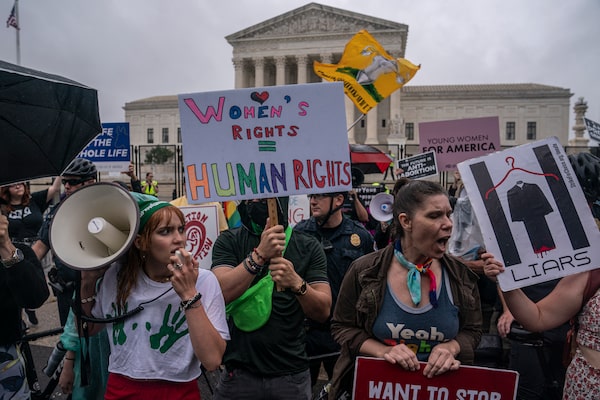
Abortion-rights activists chant during a rally in front of the Supreme Court in Washington on June 23.Nathan Howard/Getty Images
The conservative justices that now dominate the U.S. Supreme Court have knocked down a 111-year-old New York gun law, ruled in favour of public funds for religious schooling and appear poised to overturn a half-century of abortion rights.
For decades, the court has taken an incremental approach to the law, crafting decisions that hewed to the main thread of U.S. public opinion. Even the justices appointed under president Donald Trump have been considered incrementalists, and some court watchers say the momentousness of recent decisions has been overstated.
But critics say judicial caution is being dispatched by a conservative court that is proving less reluctant to topple modern precedent and more interested in returning the law to its 18th-century historical roots.
As abortion ruling nears, U.S. Supreme Court erects barricades to the public
What’s happening today “is a rapid remaking of American law,” said Joseph Fishkin, a scholar at UCLA School of Law. Such an approach to jurisprudence is not without precedent for the court. But the current approach marks a return, he said, to the early 20th century, when “the Supreme Court was regularly the branch to which conservatives turned in an effort to thwart progressive kind of reforms.”
Today’s justices ”are unconcerned about real-world consequences,” added Carolyn Shapiro, founder and co-director of the Institute on the Supreme Court of the United States at the Chicago-Kent College of Law. “They are unconcerned about disruption and the chaos that may ensue.”
Decades of recent scholarship about how the court “usually doesn’t stray too far from public opinion,” she said, are merely “a description of how the court happened to be.”
“What distinguishes the current court is not simply that it’s relatively on the activist, as opposed to passive side – but that the court is implementing a vision of the Constitution that’s pretty closely aligned with that of activists within the Republican Party.”
Such a view is buttressed by some of the court’s recent and expected decisions. On Tuesday, it ruled that a state cannot bar students seeking religious education from its tuition assistance program, a decision seen as an attack on the separation of church and state.
On Thursday, it struck down a New York State law, passed in 1913, that requires government authorization for unrestricted carrying of handguns. The court ruled that the Second Amendment, adopted in 1791, gives an individual the right to carry a handgun for self-defence outside the home, a conclusion that drew fury from Democrats.
“This ruling contradicts both common sense and the Constitution, and should deeply trouble us all,” President Joe Biden said. New York City Mayor Eric Adams, a former police captain, said the ruling “has made every single one of us less safe from gun violence,” while ignoring “the shocking crisis of gun violence every day engulfing not only New York, but engulfing our entire country.”
A draft opinion leaked in May suggests the court is preparing to overturn the Roe v. Wade and Casey cases, which have guaranteed abortion access across the country. Such a decision would be a momentous change to the country’s reproductive rights landscape, although a final opinion has yet to be released.
But a close reading of the court’s recent decisions, other scholars and lawyers say, suggests a less disruptive approach.
“Conservatives don’t make very good revolutionaries, and they never have,” said Ernest Young, a Duke University scholar of constitutional law. “A lot of the conservative justices on this court are really conservative in the sense that they want to basically defend the institutions that we have and make them stronger – and not radically change them.”
History has brought other examples of Supreme Courts that were expected to upend society but did not, he said. One book about Warren Burger, who was appointed chief justice by Richard Nixon, was titled: The Burger Court: The Counter-Revolution That Wasn’t. That court did not strike down key decisions such as one-person one-vote or the Griswold case, which ensured married couples could buy contraceptives without permission.
Indeed, it was under Mr. Burger that Roe v. Wade was released. “The pace of creating new rights slowed down. But it didn’t stop,” said Prof. Young, who was a clerk under Supreme Court justice David Souter.
He sees the current court in a similar way. The firearm restrictions in the New York law – the one struck down on Thursday – would likely not have had “much of a chance even when there was a different set of justices,” he said.
Michael Bindas, a senior lawyer with the Institute for Justice, says the court’s decision this week on school funding has been similarly misunderstood. Mr. Bindas argued that case in court, fighting successfully against a policy by the Maine Department of Education that refused tuition assistance payments to students attending nonsectarian schools.
The court’s decision was “simply adhering to this long-standing notion that the United States Constitution requires government neutrality toward religion – not hostility,” Mr. Bindas said. The Maine policy was “the embodiment of hostility toward religion,” he said.
And, he noted, such a conclusion is not novel. The Institute for Justice has brought four choice-related education cases to the court in the past two decades. In the first, decided in 2002, the court concluded that having “religious options alongside non-religious options is perfectly permissible under the U.S. Constitution,” Mr. Bindas said.
Critics have said the court is now breaching the wall between church and state.
Mr. Bindas disagrees.
“These types of programs are not about funding schools, whether religious or non-religious, in the same way that, say, the food stamp program is not about funding grocery stores or Medicaid is not about funding hospitals. It’s about providing aid to individuals and allowing them to decide where to use it.”
Our Morning Update and Evening Update newsletters are written by Globe editors, giving you a concise summary of the day’s most important headlines. Sign up today.
 Nathan VanderKlippe
Nathan VanderKlippe